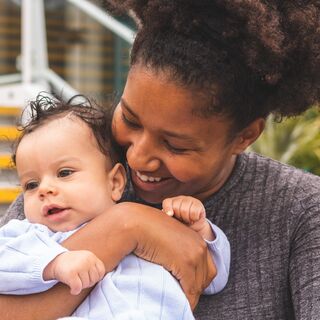Health
What Does It Mean for Children and Families to Be Healthy?
Understanding health beyond the physical.
Posted October 19, 2021 Reviewed by Ekua Hagan
Key points
- Mental health affects and is affected by both social-emotional and early relational health.
- Social-emotional and early relational health are foundational to infant and early childhood mental health.
- Adult caregivers and parents have more power to support infant and early childhood mental health by focusing on their own health.

This post was co-authored by Sarah MacLaughlin, LSW, and Rahil Briggs, Psy.D.
World Mental Health Day was October 10 and the American Academy of Pediatrics, alongside the American Academy of Child and Adolescent Psychiatry and the Children’s Hospital Association, just declared a national state of emergency in child and adolescent mental health.
These kinds of public acknowledgments about the importance of mental health suggest we have come a long way toward recognizing its impact. Yet, infant and early childhood mental health (yes, babies have mental health!) is still barely recognized among the public despite decades of research that show the disproportionate impact of early childhood on future health and well-being.
Our mental health affects and is affected by both social-emotional and early relational health (ERH). If we created a Venn diagram of the ways in which these different ways to be healthy are related, there would be a lot of overlap. It’s difficult to tease out one kind of health entirely from another.
Before talking about some ways to foster health across these different areas, let’s define each of them, as together they set babies on the path to lifelong health and well-being.
- Mental Health has previously been defined as simply an absence of mental illness, which is inaccurate. In 2004 the World Health Organization defined mental health in more complex terms with nods to well-being, coping with stress, working productively, and making community contributions (Galdersi, et al, 2015). However, this definition was at the very least incomplete. Any definition of mental health is influenced by the culture attempting to define it (Galdersi, et al, 2015). While there can be no conclusive universally applicable definition, mental health may require a “dynamic state of internal equilibrium” and should consider cognitive and social skills, self-regulation, flexibility, and the ability to cope with adverse events (Galdersi, et al, 2015).
- Social-Emotional Health and Early Relational Health both focus on the “positive, stimulating, and nurturing early relationships that ensure emotional security and connections” (Willis, 2021). The bidirectional nature of the two-generation caregiver-child relationship means that social-emotional health and ERH depend on a positive caregiver-baby relationship, one in which caregivers show warmth, affection, respect, and caring (Child Care Aware, 2019). Babies and toddlers attain health in this area when caregiving adults provide a secure base and teach and model skills such as emotion regulation, turn-taking, practicing patience, emotional literacy, and more (ZERO TO THREE, n.d.). Young children who experience ERH and have strong social-emotional skills—which are learned over time since birth—are more likely to enter classrooms ready to learn (“HealthySteps Impacts…” n.d.). With awareness and supportive policies and systems, caregivers may be better able to create and maintain the healthy attachment and relationships that provide this foundation.
- Physical Health needs no definition here, but the interplay is less understood. The ACE Study indicated that mental, social-emotional, and ERH are tied to our nervous and endocrine systems which are responsible for stress hormones including adrenaline and cortisol. These hormones, in excess, can overwhelm our systems and lead to inflammation, toxic stress, and potentially serious illness or chronic disease.
What Does This Mean for Babies and Parents?
When considering the two-generation relationship, a good portion of child well-being depends on parent well-being. As the influential pediatrician, Dr. Donald Winnicott said, “There is no such thing as a baby, there is a baby and someone,” suggesting that babies live in relationship to others and would not survive or thrive on their own. Adult caregivers and parents have more power to effect change within a family system by focusing on their own health across these areas.
The Center for Youth Wellness identified seven domains of wellness that can help parents and caregivers to engage in restorative self-care, which is essential for stress reduction. Practicing these domains is also wonderful modeling for children (Center for Youth Wellness Resources, n.d.).
- Balanced nutrition/healthy eating can mean a focus on healthful food choices, prioritizing family meals more often, or drinking more water. It can also mean caregivers involve children in meal preparation once they’re old enough to help.
- Healthy sleep habits are so restorative. Keeping regular routines and practicing good sleep hygiene (cool room, no screens before bed, etc.) can improve outcomes.
- Regular exercise/physical activity doesn’t have to mean trips to the gym. Taking a walk with a friend or going to the playground with a child is just as good.
- Psychotherapy and/or psychiatric care is an important part of health for many people. Destigmatizing this kind of care benefits everyone. Normalize psychological care whenever possible.
- Supportive relationships are needed for mental and other forms of health. Humans are interdependent and need each other to survive and thrive. Promote social interactions for families, even if they need to be virtual, outdoors, or over the phone for the time being.
- Mindfulness and meditation practices can be additional supports for relaxation, stress reduction, and overall wellness. Simple breathing practices are doable for adults and children. ZERO TO THREE has resources for families and educators.
- Time spent outdoors cannot be oversold. It doesn’t have to be a nature trail through the wilderness either. An hour spent in a city park is still a green space that will have a positive impact on everyone’s well-being.
Human beings are social creatures and we influence each other significantly. Just like physical, mental, relational, and social-emotional health all impact each other. No one is at the top of their game 100% of the time, but when caregivers and parents keep these different ways to be healthy on their radar and prioritize the seven domains of wellness, it’s more likely that everyone in their family will thrive. May we provide the sorts of supportive policies and systems to ensure this is possible.
References
Center for Youth Wellness Resources. (n.d.) Seven Domains of Wellness. Retrieved from: https://centerforyouthwellness.org/resources/
HealthySteps Impacts Important Precursors for School Readiness. (n.d.) Retrieved from: https://www.healthysteps.org/resource/healthysteps-impacts-important-pr…
Galderisi, S., Heinz, A., Kastrup, M., Beezhold, J., & Sartorius, N. (2015). Toward a new definition of mental health. World psychiatry: Official Journal of the World Psychiatric Association (WPA), 14(2), 231–233. https://doi.org/10.1002/wps.20231
Child Care Aware. (2019, July 1). What is Social-Emotional Health? Retrieved from: https://info.childcareaware.org/blog/social-emotional-health
Willis, D., MD. (2021, July 30). Early Relational Health: What the Pandemic Has Revealed. Retrieved from: https://cssp.org/2021/06/early-relational-health-what-the-pandemic-has-…
ZERO TO THREE. (n.d.). Developing Social-Emotional Skills. Retrieved from: https://www.zerotothree.org/resources/series/developing-social-emotiona…


